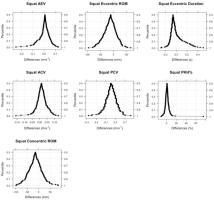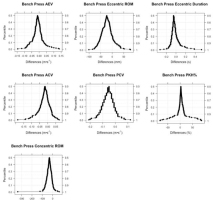Introduction
Over the past decade various studies have demonstrated the inverse, linear relationship between average concentric velocity (ACV) and the barbell load during resistance training (Carzoli et al., 2019; Ormsbee et al., 2019; Zourdos et al., 2016). Due to this linear relationship, velocity-based training (VBT) has been increasingly utilized for resistance training volume prescription or to gauge strength progress over time. For example, in lieu of prescribing 4 sets of 8 repetitions at 70% of one-repetition maximum (1RM), practitioners may prescribe 4 sets at 70% of 1RM of as many repetitions as possible until ACV falls below 80% of the first repetition’s ACV. This autoregulation of the training volume avoids using a predetermined number of repetitions since there is large inter-individual variation in the number of repetitions that can be performed during barbell exercises at the same relative intensity (Cooke et al., 2019; Shimano et al., 2006). Indeed, to date, two studies have demonstrated greater strength gains when using VBT versus percentage-based training over the long-term (Dorrell et al., 2020; Orange et al., 2019).
Despite the potential utility of VBT and the scientific calls for its usage (Dorrell et al., 2020; Orange et al., 2019), practical limitations exist such as the affordability and setup of equipment. Specifically, true criterion measures of ACV have insurmountable costs (3D Motion Capture and Force Plates) for the average practitioner, which often limits their usage to collegiate and professional strength and conditioning settings. A plethora of research has utilized linear position transducers in laboratory settings (LPTs) (Banyard et al., 2017; Dorrell et al., 2019; Ormsbee et al., 2019; Wilk et al., 2019); however, some of the most common LPTs, the Tendo Weightlifting Analyzer and GymAware Power Tool, still have exorbitant costs for the average user. The Open Barbell System (OBS) is sold at a much lower cost than the aforementioned LPTs and is an open source system; thus, it can be constructed by the consumer for an even lower cost. Although various studies have attempted to validate these LPTs, a true validation study should compare the LPT to a criterion device and use two different graphical representations of agreement (Scott et al., 2003). To our knowledge, only Goldsmith et al. (2019) have met these validation criteria (Goldsmith et al., 2019). Indeed, Goldsmith and colleagues determined validity of the OBS compared to a 3D motion capture system for both ACV and peak concentric velocity (PCV) with Bland-Altman plots showing limits of agreement of -0.03-0.04 m·s-1 for ACV. Furthermore, the OBS had better agreement with the 3D motion capture than the Tendo Weightlifting Analyzer for both ACV and PCV (Goldsmith et al., 2019).
Despite the accuracy of the OBS and its lower cost, the price still may be unaffordable for many practitioners. Low-cost options, such as the Iron Path Phone Application (IP app), PowerLift app, Beast Wearable Device, PUSH, and the free Kinovea video analysis software do exist for assessing velocity. One advantage of the Kinovea software and IP app compared to the other devices is that they can assess ROM in addition to ACV and PCV. One study established validity of Kinovea for measuring bench press velocity (Sañudo et al., 2016); however, Kinovea was only compared to the T-Force LPT, which has not yet been validated with two graphical methods of agreement similar to the OBS (Goldsmith et al., 2019; Sañudo et al., 2016). Furthermore, this study utilized a Smith machine (Sañudo et al., 2016), which has a fixed track for movement, making the translation of its findings to free-weight exercises speculative. To date, no study has compared Kinovea’s velocity or ROM measurements for barbell exercises to a validated device. Additionally, the validated OBS firmware can measure average eccentric velocity (AEV) using an “invert” function with the same approach the device uses for ACV. Carzoli et al. (2019) recently used the OBS to assess eccentric duration and demonstrated that optimizing eccentric duration is important to maximize concentric velocity. Thus, examining if free software such as Kinovea can provide interchangeable AEV measurements with a validated LPT such as the OBS would provide further utility for VBT at reduced cost to practitioners.
Therefore, the purpose of this study was to examine the agreement between the OBS and Kinovea video analysis software for ACV, PCV, concentric ROM (CROM), eccentric ROM (EROM), eccentric duration (time), and the height of PCV (PKH%) during the squat and bench press exercises. We hypothesized that there would be agreement in all outcome measures between the two devices.
Methods
Experimental Design
Participants reported to the laboratory for a total of four sessions over eight days. For the first visit, participants completed an informed consent form, a health history questionnaire, and a training history questionnaire followed by anthropometric measurements (height, body mass, and body fat percentage). After the initial measurements on visit one, participants performed a standardized dynamic warm-up composed of body-weight exercises. Then, participants completed a squat-specific warm-up (20% projected 1RM x 5 repetitions, 50% x 3, 60% x 1, 70% x 1, 80% x 1, 90% x 1) and 1RM testing for the squat in accordance with procedures from Zourdos et al. (2016). The lift-specific warm-up and 1RM testing were then repeated for the bench press. The remaining three visits, performed 48-72 hours apart, consisted of the dynamic warm-up followed by lift-specific warm-ups (20% of 1RM x 5 repetitions, 40% x 3 repetitions, and 50% x 2 repetitions) and single repetition sets at 60% and 80% of 1RM for both the squat and bench press exercises, in that order.
During 1RM attempts and single repetition sets, the OBS recorded ACV, AEV, PCV, CROM, EROM, and eccentric duration in real time, and all sets were video recorded for later analysis with Kinovea software. During visit one, the outcome measures used for analysis were all collected on the participants’ final successful 1RM attempt (i.e. their actual 1RM lift). During visit two, 3 sets of one repetition at both 60 and 80% of 1RM were performed for both the squat and bench press for a total of 12 repetitions recorded (6 repetitions for the squat and 6 for the bench press). For visits three and four, one repetition at 60 and 80% of 1RM was performed for both exercises during both visits resulting in 8 repetitions between the two days (4 repetitions for the squat and 4 for the bench press). In total, 22 repetitions (11 squats, 11 bench presses) per participant were recorded for comparison between OBS and Kinovea measurements. This structure was used as this study was part of a larger project (Carzoli et al., 2019).
Participants
Sixteen resistance trained, college-aged males participated in this study. The volunteers’ descriptive statistics can be seen elsewhere (Carzoli et al., 2019). All participants must have been performing the squat and bench press exercises ≥1 time per week for at least two years to ensure familiarity and safety with the exercises. Participants were free of any recent injuries, skeletal muscle disorders, and had no contraindications to exercise. Additionally, participants refrained from exercise 48 hours prior to the first visit and for the duration of the study. The University’s Institutional Review Board approved this investigation prior to data collection and all participants provided written consent prior to participation.
Procedures
Squat and Bench Press Execution. For the squat, participants stood straight with their hips and knees extended and the barbell placed across their upper back/shoulders. After receiving an audible “squat” command from an investigator or being prompted by a metronome as part of a larger study (Carzoli et al., 2019), participants descended by bending their knees until the top of their leg at the hip joint was below the top of their knee. They returned to the starting position on their own volition and upon receiving an audible “rack” command returned the weight to the rack. For the bench press, participants laid chest up on a flat bench with a barbell in their closed hands and elbows extended. After receiving an audible “start” command for 1RM testing or prompting by a metronome during all other testing, they descended by bending their elbows until the bar touched their chest in a controlled manner. They returned to the starting position upon their own volition and re-racked the weight after receiving an audible “rack” command. The audible commands given by investigators ensured participants did not move before they were supposed to, which allowed for accurate OBS recordings and consistent video analysis.
Open Barbell System (OBS) Setup and Recordings. Two OBS devices (Version 3.0, Squats and Science, Brooklyn, NY) were magnetically anchored to the same weight plate on the floor directly underneath where the participant would naturally un-rack the barbell. Their retractable cords were attached via Velcro to the same sleeve of the barbell and the devices were separately Bluetooth-connected to two smartphones to display measurements. One OBS recorded concentric measurements. The second one was used to obtain eccentric measurements, which could be toggled by holding down the buttons on the OBS display unit for 5 s to convert the device to the “invert” mode.
Smartphone Camera Setup. The video recordings of each participant’s repetitions were assessed upon completion of all testing. For every repetition, both OBS devices were set up on the opposite side of the camera so that they did not affect Kinovea video editing. An iPhone 5c (Apple Inc., Cupertino, CA) camera (33 frames per s) was placed on top of a 1.25 m high tripod to the side of the weight rack. The camera was aligned approximately 2.36 m away for the squat and 2.18 m away for the bench press via floor markings for consistent setup. This allowed for video recordings from the lateral perspective of all lifts and the exact placement of the camera was moved laterally to ensure proper alignment with the barbell before the lifts began.
Kinovea Analysis Process. First, on the Kinovea (Kinovea; Version 0.8.15; Kinovea open source project, www.kinovea.org) software screen, an investigator manually recorded a calibrating measurement taken as the diameter of the largest weight plate used in each video. This provided necessary information for Kinovea to produce distance and velocity measurements. Second, a digital tracker was placed on the weight plate and displayed the barbell movement path throughout the repetition. Setting this tracker to display distance measurements provided range of motion for both the eccentric (downward) and concentric (upward) phases of each repetition. Time points on the video were noted at the beginning of the lift (initiation of descent), middle of the lift (the bottom of a repetition where the transition between eccentric and concentric phases occurred), and the end of the lift (the point at which the barbell stopped ascending and came to a rest). These provided duration for each phase of a lift in seconds. The displayed distance measurements provided ranges of motion in meters. The distance measurement shown at the very bottom of the lift was the eccentric phase range of motion while the total distance displayed at the end of the lift minus the eccentric phase range of motion provided the concentric phase range of motion. The distance (m) was divided by the duration (s) to provide average velocity (m·s-1). For example, if the CROM produced by a participant was 0.95 m and he completed this portion of the lift in 1.5 s, then the ACV was (0.95 m/1.5 s) = 0.633 m·s-1. Switching the digital tracker to display velocity in each frame allowed for determination of PCV as the fastest velocity listed among all frames of a given CROM. Once PCV was found in a specific frame, the tracker was then switched to display total distance and this value could be used to calculate PKH%. For example, if the fastest velocity among all CROM frames of a lift was 0.82 m·s-1 (PCV) and this frame was then switched to display total distance traveled by the barbell as 1.85 m with 1.00 m of that being the EROM and the CROM already known to be 0.95 m, the PKH% was (1.85 m- 1.00 m)/0.95 m = 89.5%.
Statistical Analyses
Agreement between Kinovea and the OBS for all outcomes was evaluated with Bland-Altman plots (Bland and Altman, 1986) and folded empirical cumulative distribution plots (mountain plots) as graphical representations. Further agreement was assessed using paired t-tests or Wilcoxon signed-rank paired samples t-tests (based on outcomes of the Shapiro-Wilk test for normality) and intraclass correlation coefficients (ICC: based on a single-rater, absolute agreement, two-way mixed-effects model) (Koo and Li, 2016; Weir, 2005). The same ICC procedures were used in previous studies (Goldsmith et al., 2019; Kasovic et al., 2021) examining agreement between velocity calculating devices. The standard error of the measurement (SEM) was calculated as: SEM =
Results
Though all 16 participants performed 11 repetitions for each lift, recording errors resulted in 172 squat and 174 bench press repetitions accepted for analysis. Descriptive data for all dependent variables as well as ICCs and SEMs are displayed in Table 1. Paired t-tests revealed that squat AEV was the only measurement and lift comparison between OBS and Kinovea recordings that was not significantly different (p = 0.315). Kinovea produced significantly greater squat EROM, eccentric duration, PCV, and CROM, as well as greater bench press AEV, EROM, eccentric duration, ACV, PCV, and CROM. Furthermore, Kinovea produced significantly smaller values than the OBS only for squat ACV and for both squat and bench press PKH%.
Table 1
Descriptive statistics. Data are mean ± standard deviation; squat n=172, bench press n=174; *Significant difference between the OBS and Kinovea; AEV, average eccentric velocity; EROM, eccentric range of motion; Ecc Dur, eccentric duration; ACV, average concentric velocity; PCV, peak concentric velocity; PKH%, height at which PCV occurred; CROM, concentric range of motion; OBS, Open Barbell System; Kinovea, Kinovea video analysis; ICC, intraclass correlation coefficient; ICC 95% CI, intraclass correlation coefficient 95% confidence interval; SEM, standard error of the measurement.
Bland-Altman plots display the mean bias (middle dashed line) and limits of agreement (upper and lower dashed lines) around a true zero line (solid black) for all squat (Figure 1) and bench press (Figure 2) dependent variables. The mean bias and limits of agreement are displayed on each subfigure. All data points are within the limits of agreement for only squat PKH% and CROM. Mountain plots for the squat (Figure 3) and the bench press (Figure 4) show that only PKH% for each lift appears tightly conformed to the zero-difference line; however, the long tails suggest lower agreement between OBS and Kinovea measurements.
Figure 1
Bland-Altman plots showing agreement between the Open Barbell System and Kinovea video analysis in the squat. Middle dashed line indicates mean bias and outer dashed lines represent limits of agreement. AEV = average eccentric velocity; ROM = range of motion; ACV = average concentric velocity; PCV = peak concentric velocity; PKH% = height at which PCV occurred.
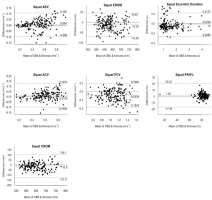
Figure 2
Bland-Altman plots showing agreement between the Open Barbell System and Kinovea video analysis in the bench press. Middle dashed line indicates mean bias and outer dashed lines represent limits of agreement. AEV = average eccentric velocity; ROM = range of motion; ACV= average concentric velocity; PCV = peak concentric velocity; PKH% = height at which PCV occurred.
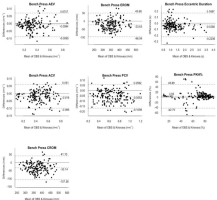
Discussion
The main finding of this study is that there were significant differences between the Kinovea video analysis software’s measures of AEV, EROM, eccentric duration, ACV, PCV, PKH%, and CROM during resistance training compared to those produced by the previously validated OBS. Specifically, Kinovea overestimated squat EROM, eccentric duration, PCV, and CROM, as well as bench press AEV, EROM, eccentric duration, ACV, PCV, and CROM. Kinovea only underestimated squat ACV and squat and bench press PKH%. The substantial lack of agreement for ROM was likely due to differences in how each device assessed ROM. Specifically, the OBS, and many other LPTs, record absolute displacement as ROM, whereas Kinovea tracks all barbell path movement as ROM. For example, if a lifter ascends 0.9 m in a squat and the barbell shifts forward by 0.1 m during their ascent, then the OBS will record the ROM as ~0.906 m (hypotenuse of vertical displacement and horizontal displacement), while Kinovea will record ROM as 1.0 m (total distance traveled) (Figure 5). It is also likely that the manual video-measuring process utilized in Kinovea further contributed to the ROM differences. Kinovea tracking commenced on the frame in which the lifter began either hip or knee flexion for the squat or elbow flexion for the bench press. In contrast, the OBS begins recording once a specific length of the retractable cord has moved, termed a “filter,” which is ~0.1 m. It is unlikely that the initial points of recording between the OBS and Kinovea coincided. Since the OBS has been previously validated, the results presented in this study suggest that practitioners should not use Kinovea for assessment of barbell velocity, duration, and ROM as these measurements are inaccurate.
Figure 5
Differences in range of motion measurements between the Open Barbell System and Kinovea video analysis. Standard squat (A; lifter facing right) and bench press (B; lifter laying supine with head towards the right) barbell movement paths depicted via curved, grey lines from a lateral aspect. Kinovea video analysis records the grey line on the concentric side of the transition point (black dot) as the concentric range of motion (CROM) while the Open Barbell System records the displacement between the transition phase and the end position (a; straight black line) as CROM. Eccentric ROM is similarly recorded from the start of the eccentric phase to the transition point (values not portrayed).
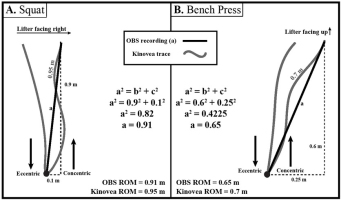
Importantly, the different ROMs and velocities cannot be separated since velocity is derived from displacement. Therefore, Kinovea’s overestimation of both squat and bench press EROM and CROM inevitably produced different values of AEV, ACV, PCV, and PKH%. With an increasing interest in VBT, it is difficult to recommend Kinovea be used for velocity-based load or volume prescription on the basis of these findings. The significantly different ACV values and large limits of agreement show that interchanging the OBS with Kinovea could lead to inappropriate training prescription.
While the current study is an agreement study and not a true validation study, Goldsmith et al. (2019) recently validated the OBS against a 3D Motion Capture system for ACV using multiple graphical representations of agreement (limits of agreement for squat ACV: -0.03-0.04 m·s- 1). The current limits of agreement between devices for squat ACV were -0.10-0.13 m·s-1, which is more than 3 times greater than that of the OBS versus 3D motion capture. Limits of agreement for both ACV and AEV in the bench press were similarly high. Recently, Carzoli and colleagues (2019) demonstrated the importance of individualizing eccentric duration to maximize both squat and bench press performance; thus, accurately gauging those metrics could allow an individual to optimize their eccentric movement. To our knowledge, this is the first study to examine agreement between devices for AEV and eccentric duration. Again, the lack of agreement in eccentric outcomes suggests that the devices should not be used interchangeably. Although the OBS has been validated against a criterion device in a free-weight movement, the difference in ROM assessment between devices remains particularly important for maximal effort lifts where extra motion at sticking points may occur. In this way, it is possible that Kinovea could provide a more complete ROM assessment than traditional LPTs. Nonetheless, on the basis of these findings, the OBS has more scientific support (Goldsmith et al., 2019) than Kinovea to accurately assess velocity metrics during resistance training.
Previously, Sañudo et al. (2016) concluded Kinovea to have concurrent validity with the T-Force LPT for bench press mean propulsive velocity. However, Sañudo and colleagues (2016) conducted their bench press testing on a Smith machine, which eliminated sagittal movement by creating a perfectly vertical barbell path; thus, this comparison cannot be extrapolated to free-weight barbell exercises. Moreover, the use of free weights and resultant horizontal motion of the barbell likely explains some of the variance in ROM and velocity measurements between devices in this study. Additionally, many other studies examining validation of velocity or agreement between devices, such as the PUSH band, GymAware Power Tool, Tendo Fitrodyne, and Kinovea failed to report at least two forms of agreement plots (i.e. Bland-Altman plots and Mountain plots) (Banyard et al., 2017; Dorrell et al., 2019; McGrath et al., 2018; Sañudo et al., 2016), which are recommended as the most appropriate method to examine agreement (Scott et al., 2003). To our knowledge, the current study is only the second to use two graphical representations of agreement for VBT devices in addition to the study of Goldsmith et al. (2019), which originally validated the OBS. Lastly, it is worth noting that the manual editing process can provide a source of error and we did not obtain ICC values for these data.
A major limitation of this study is that the findings cannot necessarily be extrapolated to the full spectrum of exercises that could be analyzed. While we chose the squat and the bench press due to their common use in resistance training programs, this focus limits expanding on Kinovea’s and OBS’s applicability to more advanced lifts such as Olympic weightlifting movements. Future research should consider analyzing exercises that require more complex movement and technical mastery from an athlete. Furthermore, researchers should test displacement, in lieu of total distance, to assess if that improves Kinovea’s agreement with validated velocity-measuring devices for ROM measurements. Lastly, Kinovea calibration measurements for each video likely had slight human errors despite consistent adherence to the calibration protocol.
Conclusions
A practical benefit of the OBS compared to Kinovea is that the OBS provides immediate velocity or ROM feedback on the display screen or a Bluetooth connected smart phone, whereas Kinovea requires post-processing. The immediate feedback from the OBS makes it a more practical option for coaches and athletes aiming to autoregulate training loads or volume using real-time velocity feedback. Specifically, if an aspect of VBT was to be used, such as velocity loss, the OBS could facilitate this training technique in the immediate, while Kinovea could not. If an individual load-velocity profile is known, that lifter could use the OBS to terminate a set at a specific velocity that they know corresponds to a certain number of repetitions in reserve to ensure the appropriate stimulus. For example, if 0.35 m·s-1 corresponds to 2 repetitions in reserve (Zourdos et al., 2016), then a lifter could position a Bluetooth-linked smartphone where velocity could be viewed and would perform reps until velocity was ≤0.35 m·s-1.
Despite the lack of agreement between Kinovea and the OBS, Kinovea can provide unique data on barbell movement tracking that LPTs cannot. If a coach wishes to measure and adjust the barbell movement path for an athlete, as is common for technique improvements, Kinovea can be used to display the movement trace and quantify the movement beyond what a standard video could provide. However, based on the lack of agreement between Kinovea and the validated OBS for this study’s resistance training outcome measures, we do not advise utilizing Kinovea for velocity, duration, or displacement-based ROM measures. Still, the open source aspect of Kinovea makes it very attractive to individuals with greater financial restraints and for general teaching purposes, even if its accuracy in free-weight compound movements is in question.


